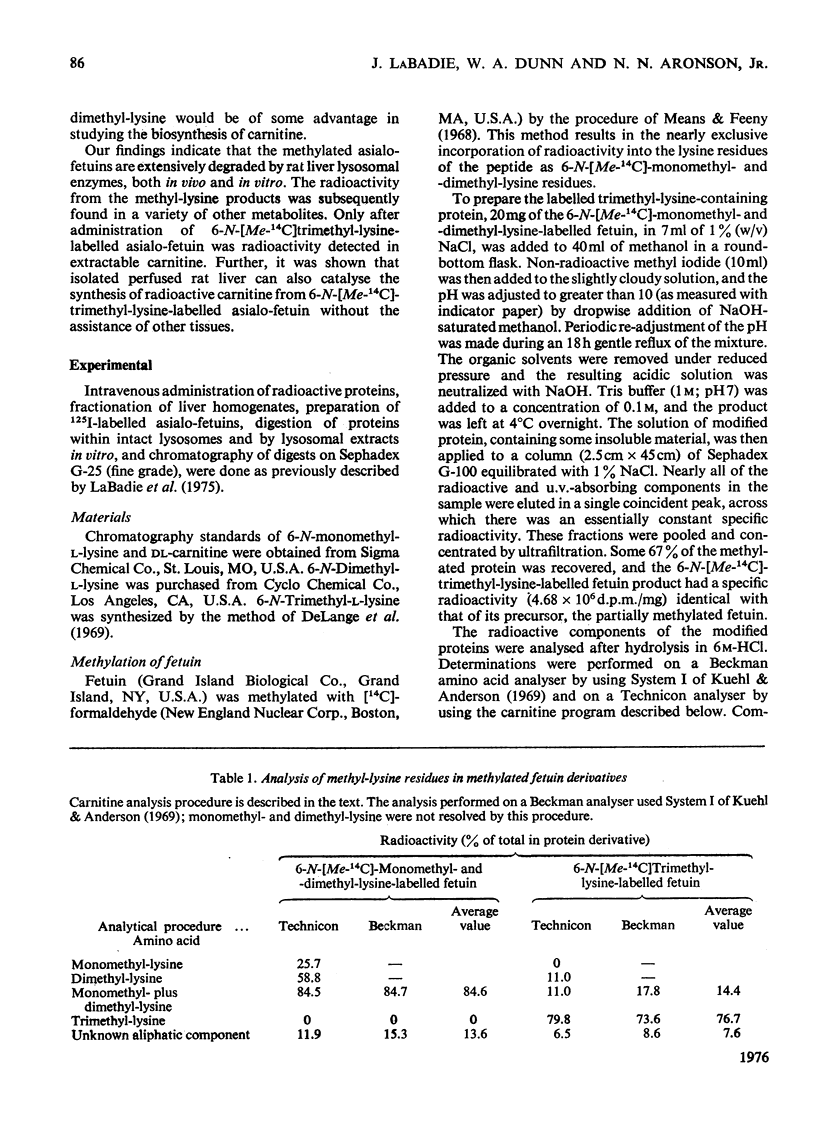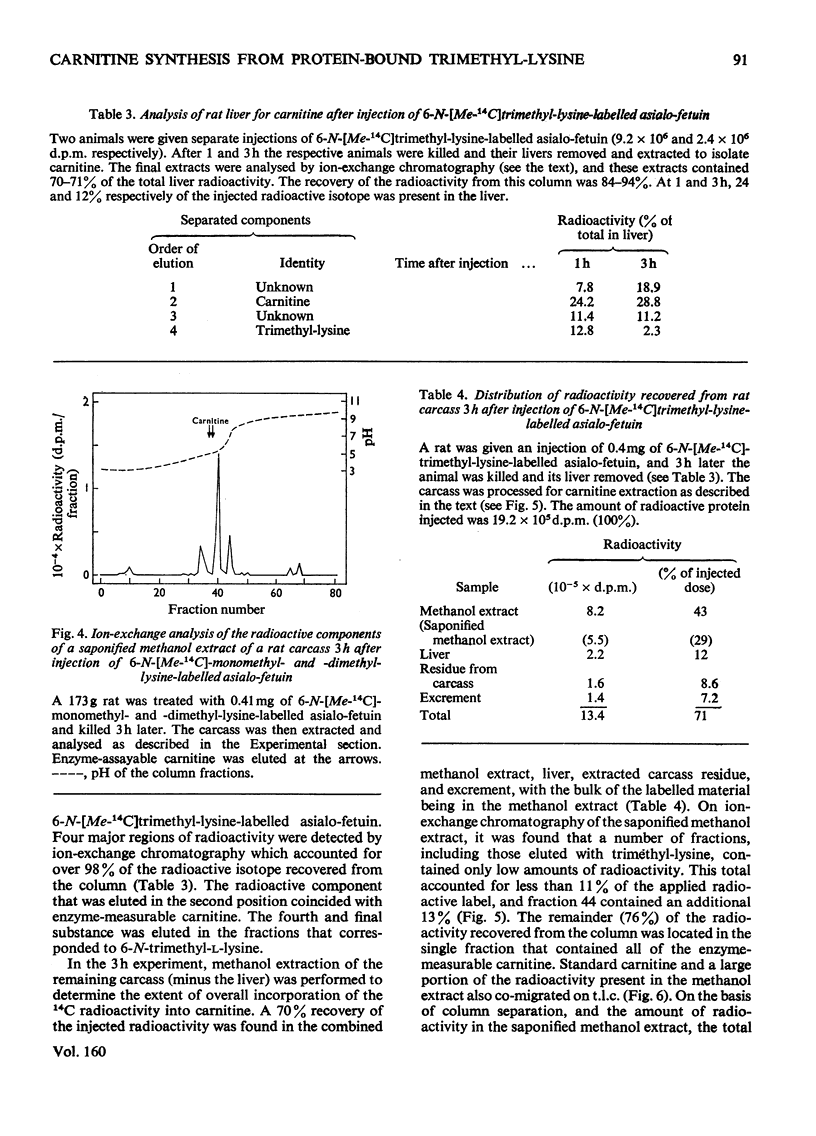Abstract
The biosynthesis of carnitine in the rat was studied by following the metabolism of two radioactive derivatives of asialo-fetuin. The first contained 14C-labelled methyl groups covalently bound to the 6-N-amino fraction of its lysine residues as 6-N-monomethyl- and dimethyl-lysine. By treating this protein with iodomethane, a second derivative was produced in which the radioactivity was preferentially incorporated as 6-N-[Me-14C]-trimethyl-lysine. These desialylated glycoproteins, like other asialo-proteins, were immediately cleared from the blood by rat liver. Within hepatocyte lysosomes, the 14C-labelled proteins were rapidly hydrolysed, producing free amino acids containing the various 6-N-[Me-14C]methylated lysine residues. The radioactive amino acids crossed the lysosomal membrane and were further metabolized in the cytosol. Carnitine was the major radioactive metabolite detected in extracts of the rat carcass and liver after intravenous injection of 6-N-[Me-14C]trimethyl-lysine-labelled asialo-fetuin. Within 3h, at least 34.6% of the trimethyl-lysine in the administered protein was converted into carnitine. Similarly, an isolated perfused rat liver converted 30% of the added peptide-bound trimethyl-lysine into carnitine within 90 min. On the other hand, in numerous attempts we failed to detect radioactive carnitine in both rat liver and carcass between 20 min and 22 h after injection of 6-N-[Me-14C]-monomethyl- and -dimethyl-lysine-labelled asialo-fetuin. These data provide evidence for a pathway of carnitine biosynthesis that involves trimethyl-lysine as a peptide-bound precursor as proposed by R.A. Cox & C.L. Hoppel [(1973) Biochem. J. 136, 1083-1090] and V. Tanphaichitr & H.P. Broquist [(1973) J. Biol. Chem. 248, 2176-2181]. The findings also show that rat liver can synthesize carnitine without the aid of other tissues, but cannot convert free partially methylated lysines into trimethyl-lysine.
Full text
PDF










Selected References
These references are in PubMed. This may not be the complete list of references from this article.
- Ashwell G., Morell A. G. The role of surface carbohydrates in the hepatic recognition and transport of circulating glycoproteins. Adv Enzymol Relat Areas Mol Biol. 1974;41(0):99–128. doi: 10.1002/9780470122860.ch3. [DOI] [PubMed] [Google Scholar]
- Brooks D. E., McIntosh J. E. Turnover of carnitine by rat tissues. Biochem J. 1975 Jun;148(3):439–445. doi: 10.1042/bj1480439. [DOI] [PMC free article] [PubMed] [Google Scholar]
- Cantoni G. L. Biological methylation: selected aspects. Annu Rev Biochem. 1975;44:435–451. doi: 10.1146/annurev.bi.44.070175.002251. [DOI] [PubMed] [Google Scholar]
- Cox R. A., Hoppel C. L. Biosynthesis of carnitine and 4-N-trimethylaminobutyrate from 6-N-trimethyl-lysine. Biochem J. 1973 Dec;136(4):1083–1090. doi: 10.1042/bj1361083. [DOI] [PMC free article] [PubMed] [Google Scholar]
- Cox R. A., Hoppel C. L. Biosynthesis of carnitine and 4-N-trimethylaminobutyrate from lysine. Biochem J. 1973 Dec;136(4):1075–1082. doi: 10.1042/bj1361075. [DOI] [PMC free article] [PubMed] [Google Scholar]
- DeLange R. J., Glazer A. N., Smith E. L. Presence and location of an unusual amino acid, epsilon-N-trimethyllysine, in cytochrome c of wheat germ and Neurospora. J Biol Chem. 1969 Mar 10;244(5):1385–1388. [PubMed] [Google Scholar]
- González de Galdeano L., Bressler R., Brendel K. Inhibition of gluconeogenesis in the isolated perfused rat liver by -phenylalkanoic acids. J Biol Chem. 1973 Apr 10;248(7):2514–2520. [PubMed] [Google Scholar]
- Haigler H. T., Broquist H. P. Carnitine synthesis in rat tissue slices. Biochem Biophys Res Commun. 1974 Feb 4;56(3):676–681. doi: 10.1016/0006-291x(74)90658-5. [DOI] [PubMed] [Google Scholar]
- Horne D. W., Broquist H. P. Role of lysine and -N-trimethyllysine in carnitine biosynthesis. I. Studies in Neurospora crassa. J Biol Chem. 1973 Mar 25;248(6):2170–2175. [PubMed] [Google Scholar]
- Horne D. W., Tanphaichitr V., Broquist H. P. Role of lysine in carnitine biosynthesis in Neurospora crassa. J Biol Chem. 1971 Jul 10;246(13):4373–4375. [PubMed] [Google Scholar]
- Kakimoto Y., Akazawa S. Isolation and identification of N-G,N-G- and N-G,N'-G-dimethyl-arginine, N-epsilon-mono-, di-, and trimethyllysine, and glucosylgalactosyl- and galactosyl-delta-hydroxylysine from human urine. J Biol Chem. 1970 Nov 10;245(21):5751–5758. [PubMed] [Google Scholar]
- Kuehl W. M., Adelstein R. S. Identification of epsilon-N-monomethyllysine and epsilon-N-trimethyllysine in rabbit skeletal myosin. Biochem Biophys Res Commun. 1969 Sep 24;37(1):59–65. doi: 10.1016/0006-291x(69)90880-8. [DOI] [PubMed] [Google Scholar]
- LaBadie J. H., Chapman K. P., Aronson N. N., Jr Glycoprotein catabolism in rat liver: Lysosomal digestion of iodinated asialo-fetuin. Biochem J. 1975 Nov;152(2):271–279. doi: 10.1042/bj1520271. [DOI] [PMC free article] [PubMed] [Google Scholar]
- Means G. E., Feeney R. E. Reductive alkylation of amino groups in proteins. Biochemistry. 1968 Jun;7(6):2192–2201. doi: 10.1021/bi00846a023. [DOI] [PubMed] [Google Scholar]
- Paik W. K., Kim S. Epsilon-alkyllysinase. New assay method, purification, and biological significance. Arch Biochem Biophys. 1974 Nov;165(1):369–378. doi: 10.1016/0003-9861(74)90175-1. [DOI] [PubMed] [Google Scholar]
- Paik W. K., Kim S. Protein methylation: chemical, enzymological, and biological significance. Adv Enzymol Relat Areas Mol Biol. 1975;42:227–286. doi: 10.1002/9780470122877.ch5. [DOI] [PubMed] [Google Scholar]
- Tanphaichitr V., Broquist H. P. Role of lysine and -N-trimethyllysine in carnitine biosynthesis. II. Studies in the rat. J Biol Chem. 1973 Mar 25;248(6):2176–2181. [PubMed] [Google Scholar]
- Tanphaichitr V., Horne D. W., Broquist H. P. Lysine, a precursor of carnitine in the rat. J Biol Chem. 1971 Oct 25;246(20):6364–6366. [PubMed] [Google Scholar]


